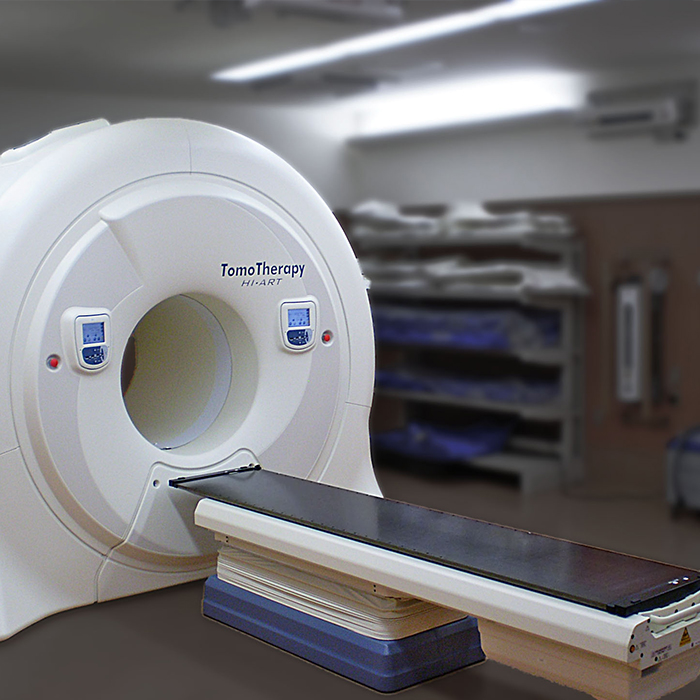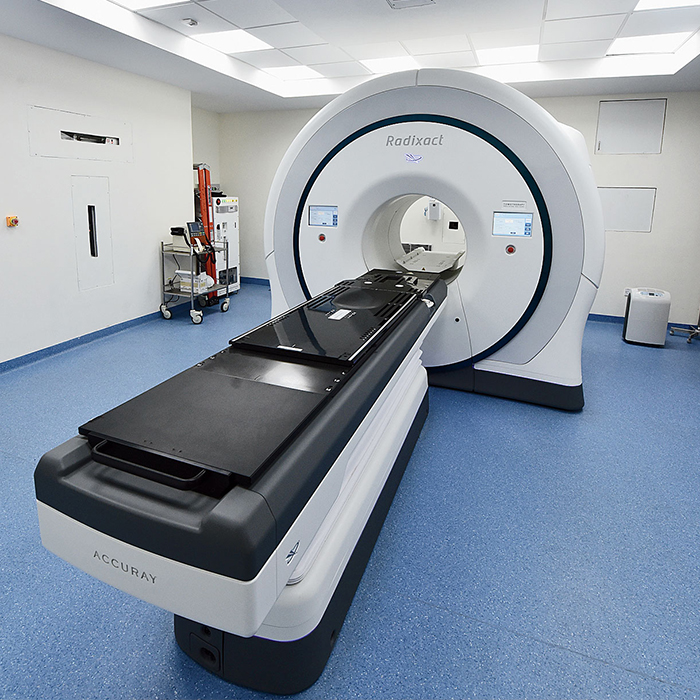
Radiation Oncology
Valentis Cancer Hospital is equipped to state of the art radiotherapy equipments Radiation Oncology is a branch of medical specialty that uses ionising radiation in form of x-ray to treat cancer patients and some non cancerous conditions.
TomoTherapy
The TomoTherapy System is intended to deliver image-guided, intensity-modulated radiation therapy (IG-IMRT) for the treatment of cancer and other diseases in a safe and routine manner. The integration of a computed tomography (CT) scanner to perform daily imaging before each treatment session distinguishes the TomoTherapy System from conventional radiation systems.
The daily imaging capability allows clinicians to detect and correct for changes in patient positioning, tumour changes, or other factors such as weight gain or loss, ensuring the continued precise and as well as the safe delivery of the radiation dose to the target area Because the TomoTherapy System's precision reduces radiation exposure to surrounding healthy tissue,
Many doctors report that their patients have fewer side effects than patients who receive traditional forms of radiation therapy.
Because of the precision, the TomoTherapy System may be used to treat patients who have previously received radiation therapy if their cancers have returned using the re-treatment functionality.
Why Is Precision Important?
Manufacturers of external-beam radiation therapy equipment have improved the precision of their delivery systems thanks to technological advancements.
Generally speaking:
- The radiation beam must enter and exit the body;
- The device's design restricts how radiation beams can be directed into the body
- The device may deliver some radiation to the tissue surrounding the tumour during treatment due to tumour motion.

Tomotherapy delivers continuous radiation from 360 degrees around the patient or from clinician-specified beam angles. These distinguishing characteristics, when combined with daily 3D image guidance, enable physicians to deliver highly accurate, individualised dose distributions that precisely conform to the shape of the patient's tumour while minimising dose to normal, healthy tissue, resulting in fewer side effects for patients. The system aids in the treatment of all standard radiation therapy indications, including breast, prostate, lung, and head and neck cancers, as well as complex treatments like total marrow irradiation.
Patients benefit greatly from the new generation of TomoTherapy
- Daily imaging allows doctors to see their tumour shrinkage on a daily basis, allowing them to limit the dose to the tumor/cancer rather than the healthy tissue, resulting in fewer complications and far superior tumour control.
- Low CT imaging dose with Iterative imaging allows patients with metal implants, such as dentures, pacemakers, or orthopaedic implants, to receive highly accurate treatments because imaging can be performed without artefacts.
- High local tumour control • Low dose to healthy tissue and normal anatomical organs such as the eyes, lungs, heart, kidneys, parotid glands, and other organs that perform important functions in the body, etc.
- High survival rate - Fewer radiation complications or side effects
- Fewer radiation complications or side effects • Targeted treatments become a reality • Dose is restricted to the target or tumour • Complicated and paediatric treatments can be treated with confidence
Size of the treatment field
Due to late diagnosis, large filed cancer is common, and patients frequently end up with large tumors/cancers or at multiple sites:
- Without a junction, there is no overlapping dose, resulting in highly conformal treatments and fewer complications and side effects due to high dose to healthy tissue or organs in the case of regular linac-based treatment.
- The most complex treatment needs are straightforward, with a simplified workflow, resulting in high patient comfort and far superior outcomes.
This is an important requirement in the region because, according to reports, the majority of patients in the region require large field treatments due to the following factors:
- The region has a low cancer detection rate, with only 2030% of cancer diagnosed in stages 1 and 2.
- The region has a higher incidence of Prostate, H&N, Lung, Breast, and GI cancers, accounting for up to 80-90% of cancer in the region, and TomoTherapy has far superior treatment results in these areas.
- Brain cancers and benign brain tumours
- Head, neck, and oral cancers
- Breast cancers, including inflammatory breast disease (both Unilateral & Bilateral)
- Lung cancers and lung tumours
- Skin cancers
- Prostate cancer, from early-stage to advanced disease
- Oesophageal and upper gastrointestinal cancers
- Cervical, ovarian, uterine, vaginal, and vulva cancers
- Colon, stomach, rectal, and anal cancers